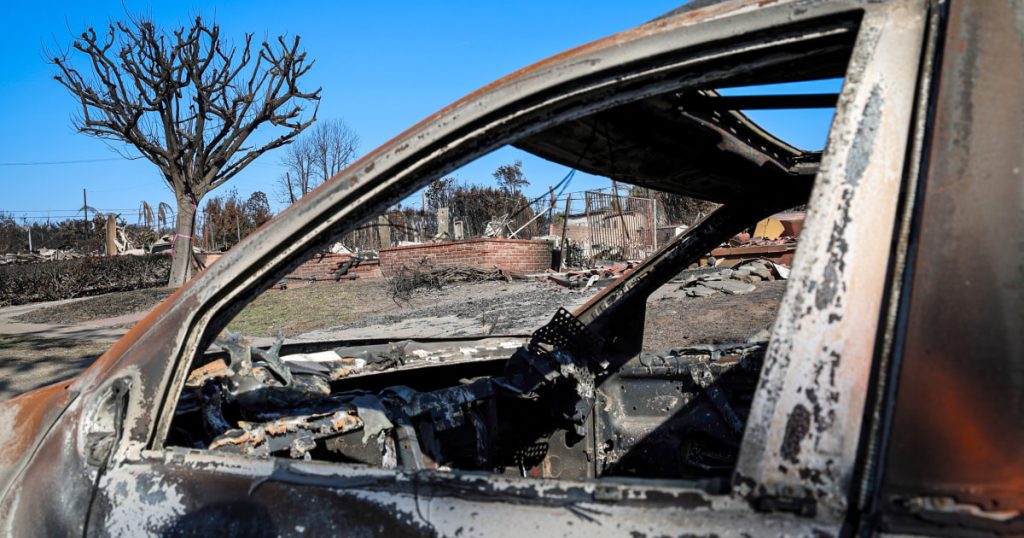Summarize this content to 2000 words in 6 paragraphs The SummaryOne of the biggest cleanup challenges from the Southern California fires is lithium-ion batteries, which can explode after damage or exposure to heat.The batteries are found in electric vehicles, which abounded in some burned neighborhoods, including Pacific Palisades.The process of neutralizing the batteries is complex, requiring a high level of technical sophistication.As cleanup efforts get underway in the Los Angeles area neighborhoods marred by wildfires, one of the biggest challenges is the large number of lithium-ion batteries that were caught in the flames.The batteries power most plug-in hybrid cars and electric vehicles, and are used in golf carts, e-bikes, laptops, cellphones and wireless earbuds. They’re also found in power banks that provide backup energy during outages, which have become increasingly popular in homes.If damaged or overheated, lithium-ion batteries can ignite or even explode — residual heat sets off a chain reaction that causes the batteries to heat up uncontrollably and spontaneously combust, a process that can happen over days, weeks or months.Properties in Pacific Palisades and Altadena, where the Palisades and Eaton fires have collectively destroyed at least 12,000 structures, had higher-than-average numbers of electric vehicles, officials said.“This will be … from our estimation, probably the largest lithium-ion battery pickup, cleanup, that’s ever happened in the history of the world,” said Steve Calanog, the Environmental Protection Agency’s incident commander for the Palisades and Eaton fire cleanups.But that cleanup process is complex and resource-intensive.The California Office of Emergency Services has already sent hazmat teams to inspect homes for lithium-ion batteries and flag where they’re present. The EPA has what it refers to as a battery recovery team that will oversee efforts to collect them. Chris Myers, a lithium-ion battery technical specialist involved in the EPA cleanup, said the collection process could start as early as Monday.“It is very likely that these batteries were not all consumed in the fire, so now they’re damaged, which means they’re all dangerous,” he said. Myers explained that the battery systems in hybrid and electric cars are well-protected, so even vehicles that were damaged by the fires may still have charged batteries.Handling the batteries “requires a great deal of technical sophistication and care,” Calanog said. The EPA team must wear flame-resistant clothing underneath disposable protective suits. Masks cover their faces, and either come with insertable cartridges to filter out chemicals or attach to air tanks. The crew blocks off the area where it’s working and keeps water on site in case flames erupt.Before they can be sent to a waste or recycling facility, the collected batteries must be de-energized so that they hold no charge or very little. To do that, Myers said, the EPA will likely use a process developed after the Maui wildfire in 2023, which involves submerging the batteries in a solution of saltwater and baking soda. Once the batteries have lost their charges, they can be crushed with a steamroller or shipped to a facility in special packaging.Lithium-ion batteries have become a mounting issue after wildfires, given the rising sales of hybrid and electric cars, particularly in California. The state will require 35% of new vehicles sold in the state to be zero-emission by 2026, and all new vehicles to be zero-emission by 2035.In Los Angeles County, at least 581,000 zero-emission vehicles — including plug-in hybrids and fully electric cars — were sold in the last 15 years, around 99,000 of which were sold in 2024, according to the California Energy Commission. In Pacific Palisades alone, more than 5,500 zero-emission vehicles were sold from 2010 to 2024.“There is a very large number of electric vehicles in this area — probably way more than in other areas,” said Adam VanGerpen, a public information officer for the Los Angeles City Fire Department. “A lot of these people also had solar roofs and solar batteries for the wall power banks.”Yuzhang Li, a professor of chemical and biomolecular engineering at UCLA, said the riskiest batteries are those in cars that were partially burned, rather than fully destroyed.“If the electric vehicle has already caught on fire and been burnt out, then I would say the risk is relatively minimal, because presumably all of the fire has destroyed the battery,” he said.As authorities begin the enormous process of cleaning up from the Southern California fires, their first priority — which the EPA calls “phase one” — is to remove hazardous waste such as asbestos, batteries, oil and paint from properties, since the materials can release toxic fumes.The entire process could take about six months, Calanog said.Myers said the battery recovery process won’t slow down that timeline, though “the scale here is certainly a big challenge.”As for where to dispose of the hazardous waste, Calanog said the EPA has not decided yet, and a number of sites are available.However, VanGerpen said many facilities that receive hazardous waste are located outside California, and there may be limits to how much waste they’re willing to accept.The waste must be cleared before authorities can move on to the next phase of the cleanup: removing debris. VanGerpen urged residents to avoid sifting through rubble until their property has been deemed safe.“Residents should not go and try to remove hazardous debris,” he said. “Just your normal household items can be dangerous and pose a risk.”


